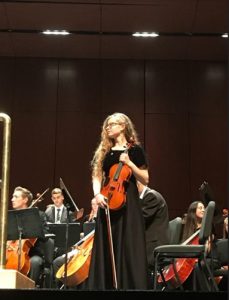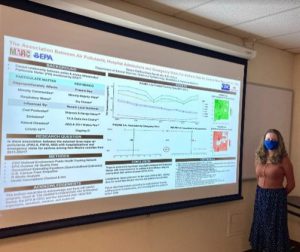
At 9 years old, Raven Delfina Otero-Symphony wanted to be an astronaut. As a fourth-year statistics student at the University of New Mexico, Albuquerque, she still dreams of working for NASA—but as a statistician. You might be surprised to learn that she spent high school and her first semester of college preparing for a career in music, convinced that science and mathematics weren’t for her.
Strings to Stats
Raven enjoyed and excelled in both STEM and humanities classes as a child. As she got older, her interest in STEM wasn’t encouraged, and she began to believe she “just wasn’t a science person.” She concentrated on music because she felt very supported in that pursuit. She played the viola—a stringed instrument slightly larger and deeper in tone than a violin—and performed in symphonies throughout high school.

After graduating, Raven attended the University of New Mexico (UNM) on a music scholarship. During her first semester, however, she began to question her goal of a career in music. When her aunt mentioned the growing need for statisticians, Raven researched the field. “I really liked statistics because of its versatility,” she says. “To me, it was different than pure mathematics because it wasn’t so logically strict. Applied statistics had the creative STEM impact I’d been looking for.”
Raven switched her major to statistics and received an El Puente Research Fellowship shortly afterward, which enabled her to learn about the process of scientific research and be mentored by a member of UNM’s sociology department. That experience sparked a desire to find out more about the role of statistics in research.
Seizing Moments of Opportunity
As she was leaving campus one day during her sophomore year, Raven noticed a flyer advertising an NIGMS-supported Maximizing Access to Research Careers (MARC) program that provided biomedical research experience and helped students prepare for graduate school. It sounded like the opportunity she’d been looking for, but she figured she’d missed her chance—the application deadline was that day! The more she thought about the flyer, though, the more she felt like it was an opportunity she couldn’t pass up.
“I went back to the university and ran to the office, but it was locked,” says Raven. “I thought, I guess it just wasn’t meant to be.” Then she noticed a room with “MARC” on the door, and she stopped to talk to the students inside. When they passed along her interest to the director, he extended the application deadline, and soon after, Raven was accepted into MARC.
Through the program, Raven has contributed to research on infectious diseases, cancer, and environmental science. During the summer of 2021, she interned with the Harvard T. H. Chan School of Public Health, applying statistics and data science to nutrition studies. MARC has also provided networking opportunities with scientists from a range of backgrounds. “Nobody in my family is a scientist or has a Ph.D., so seeing Hispanic scientists at the Ph.D. level inspires me,” Raven says.

An additional benefit of the program has included attending scientific conferences, such as the virtual 2020 Society for Advancement of Chicanos/Hispanics & Native Americans in Science (SACNAS) conference. During SACNAS, Raven heard a speaker discuss how the histories of people from underrepresented groups are often erased. At the end of the talk, she posed a question to the speaker describing her own experience as a first-generation Hispanic college student. An editor from Science was listening and asked Raven and other attendees if they’d be willing to share what their journeys in science had been like in relation to their cultural identities. Raven jumped at the chance and wrote a piece for the magazine that was published in April 2021.
Looking Forward
After graduating from UNM in the spring of 2022, Raven hopes to enter an interdisciplinary statistics Ph.D. program—a goal inspired by MARC—and work at the intersection of biomedical and earth science research. She also plans to buy her own viola and play in her spare time, as she sees a strong parallel between her roles in science and music. “Statistics brings balance to the scientific disciplines, just like the viola brings balance to the symphony,” Raven says. “They’re both vital, even though they’re in the background much of the time.”
Raven is part of the UNM MARC program, which is supported by NIGMS grant T34GM008751.


Wow! The history of this young lady, Raven, is very inspiring. I wish her the best and pray that she be able to complete her Ph.D.